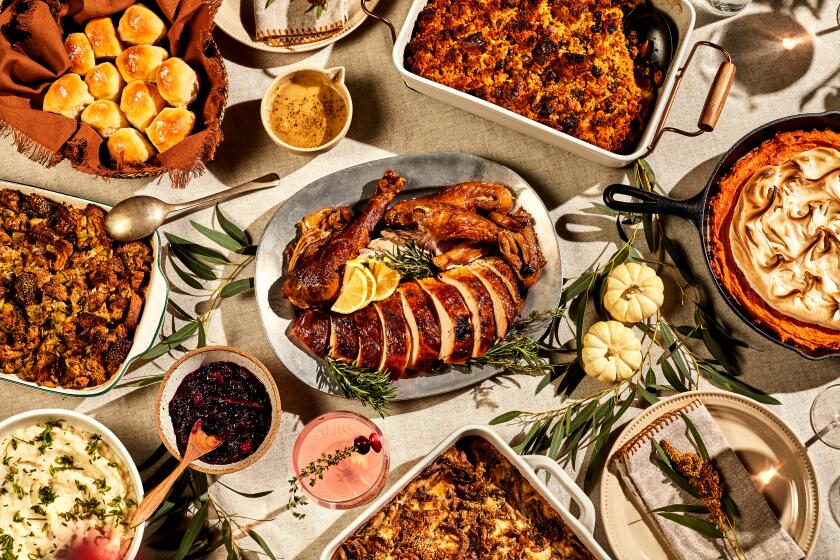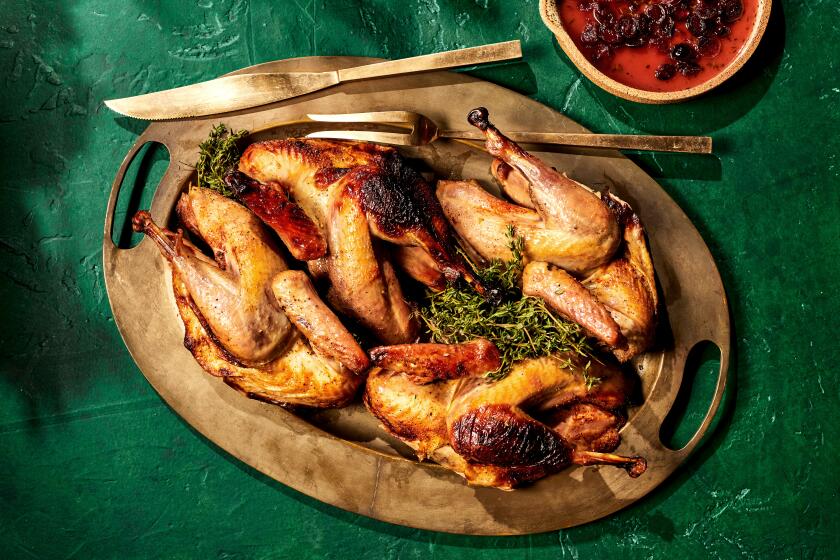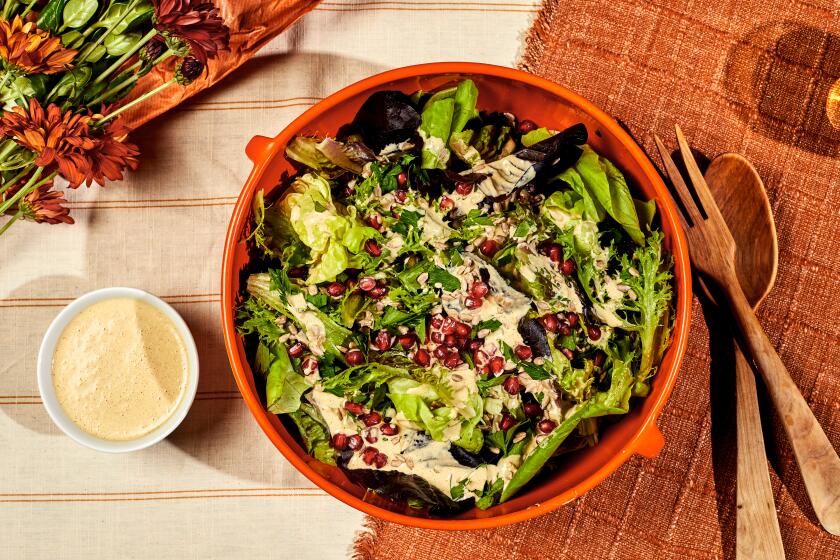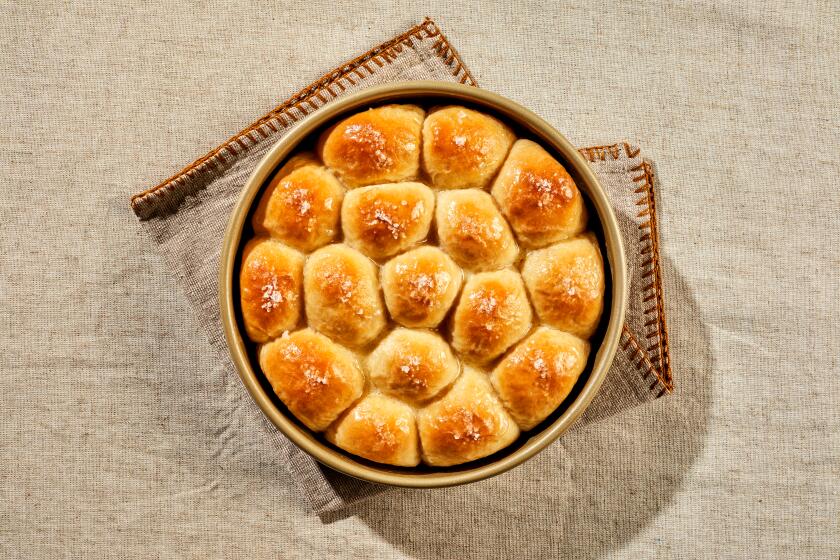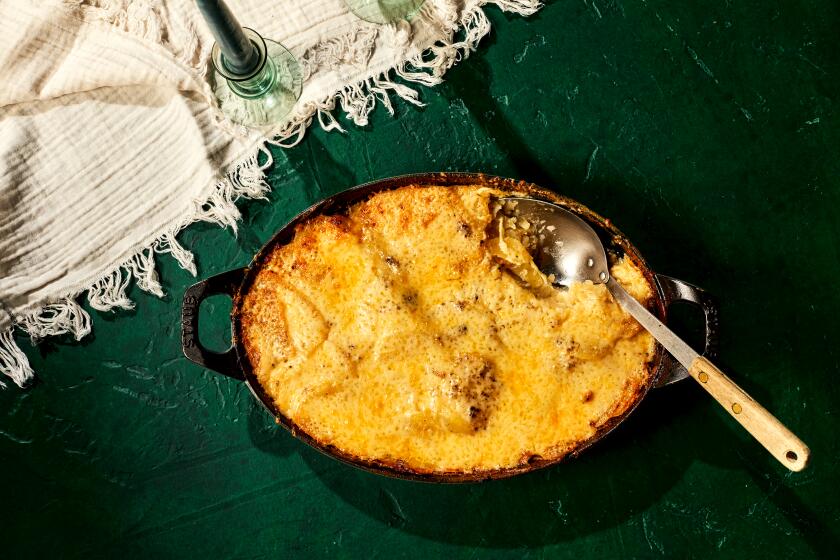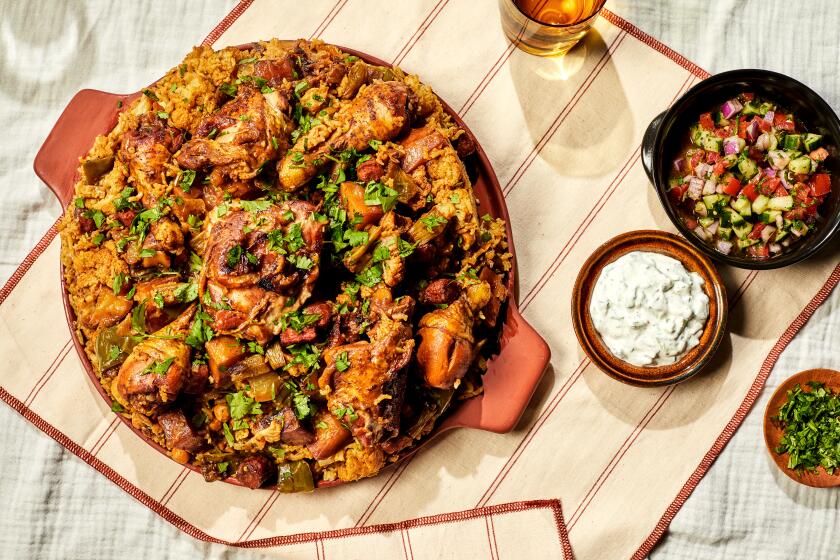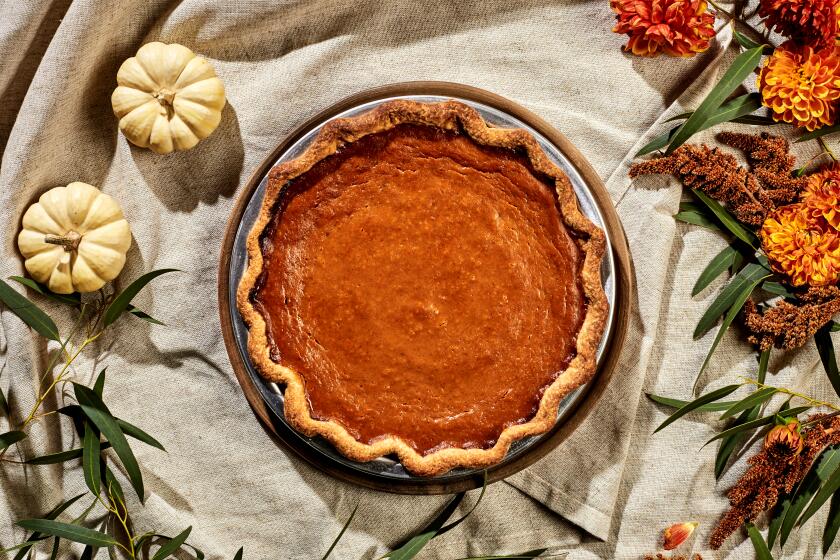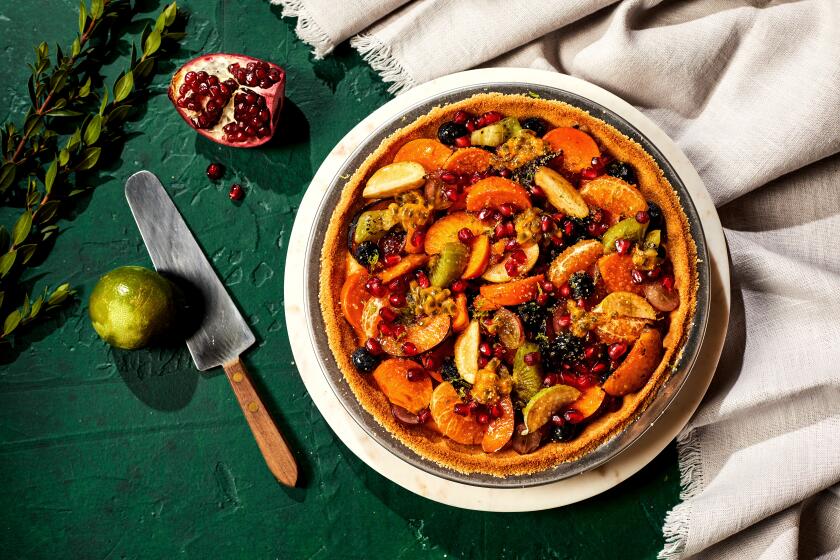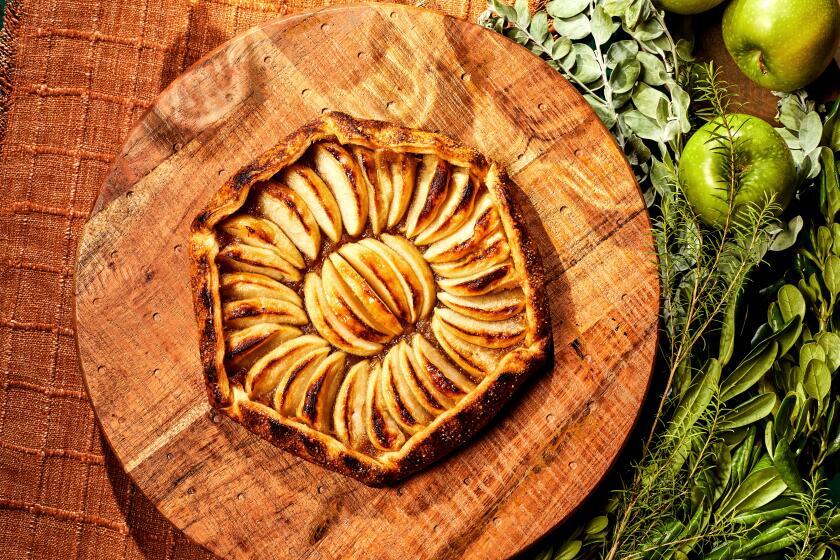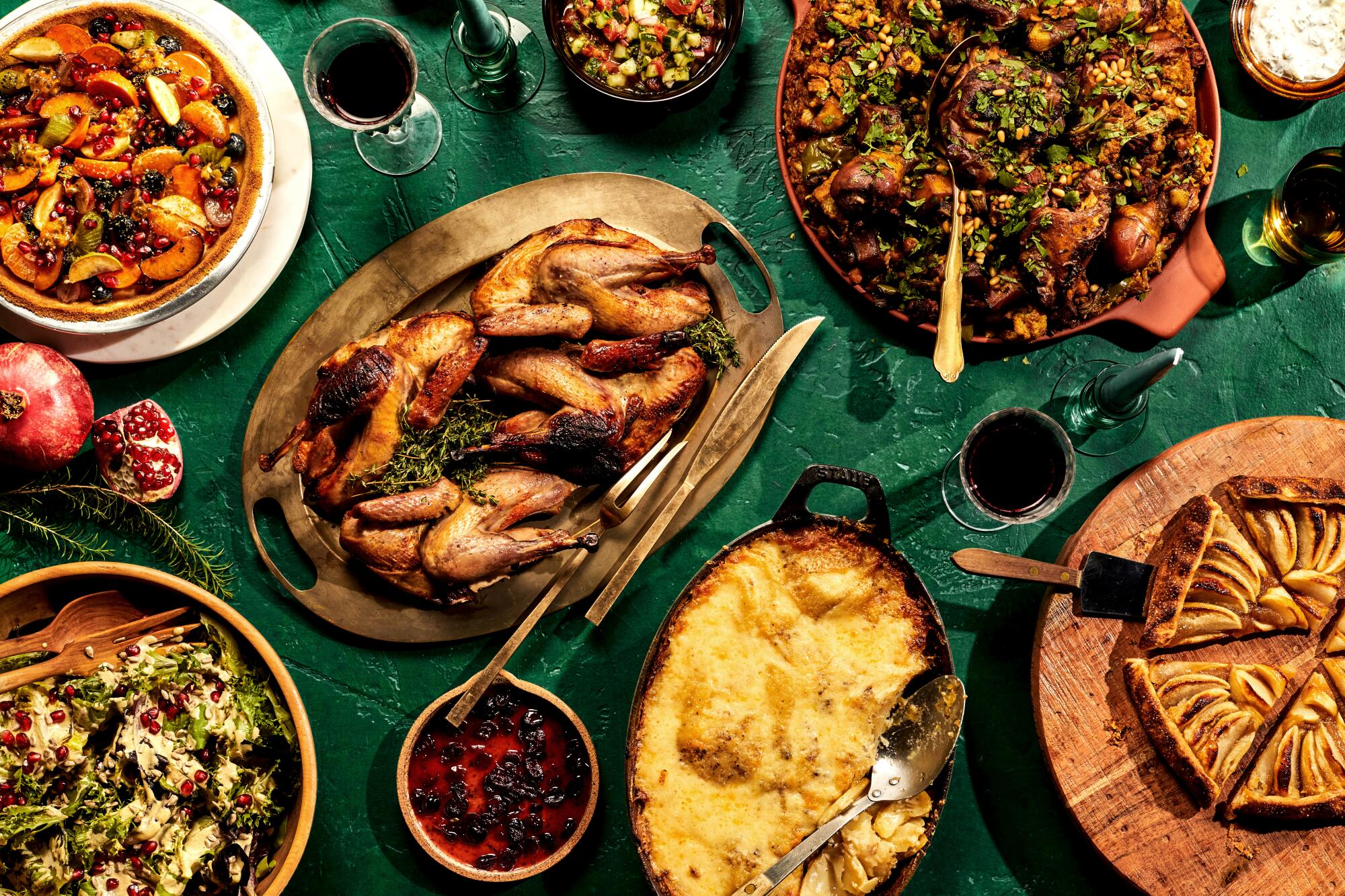
When Thanksgiving rolls around each year, some things are certain: Turkeys will be roasted, potatoes will be mashed, and so many pumpkin pies will be baked on the big day. And while the tried-and-true classics are wonderful, not everyone’s holiday table looks so Rockwell-ian.
In kitchens across L.A., cooks adapt the Thanksgiving credo of “gather together with loved ones over fabulous food” to make dishes that speak to their own holidays past or influences from their family heritage. Or someone brought an oddball dish one year, and now it has a forever place at the Thanksgiving table. It’s a dish that makes the holiday feel even more like home.
Roast turkey, easy gravy, green bean gratin, bright cranberry sauce, creamy potatoes and two kinds of stuffing (vegan or not) plus three stellar pies — these are all the classic Thanksgiving recipes you’ll ever need.
I spoke with six cooks in Los Angeles to get their essential holiday recipes — and the stories that inspired them. Some are classics — a bubbling, cheesy potato gratin or a browned, fragrant and elegant apple galette — while others are passed-down celebration dishes that fit the season, like an elaborate Palestinian upside-down chicken and rice dish or bronzed pheasants roasted under bacon. Others are updates on nostalgic favorites, like a nutty and addictive salad dressing from college days or a beautiful tart made with seasonal fruit and a rich custard that evokes desserts in the grocery store sweets case.
These dishes are expressions of each cook, showing their conviviality at the holiday while also honoring past traditions that got them to where they are now. Without them, Thanksgiving just wouldn’t be the same.
The Home Cooks
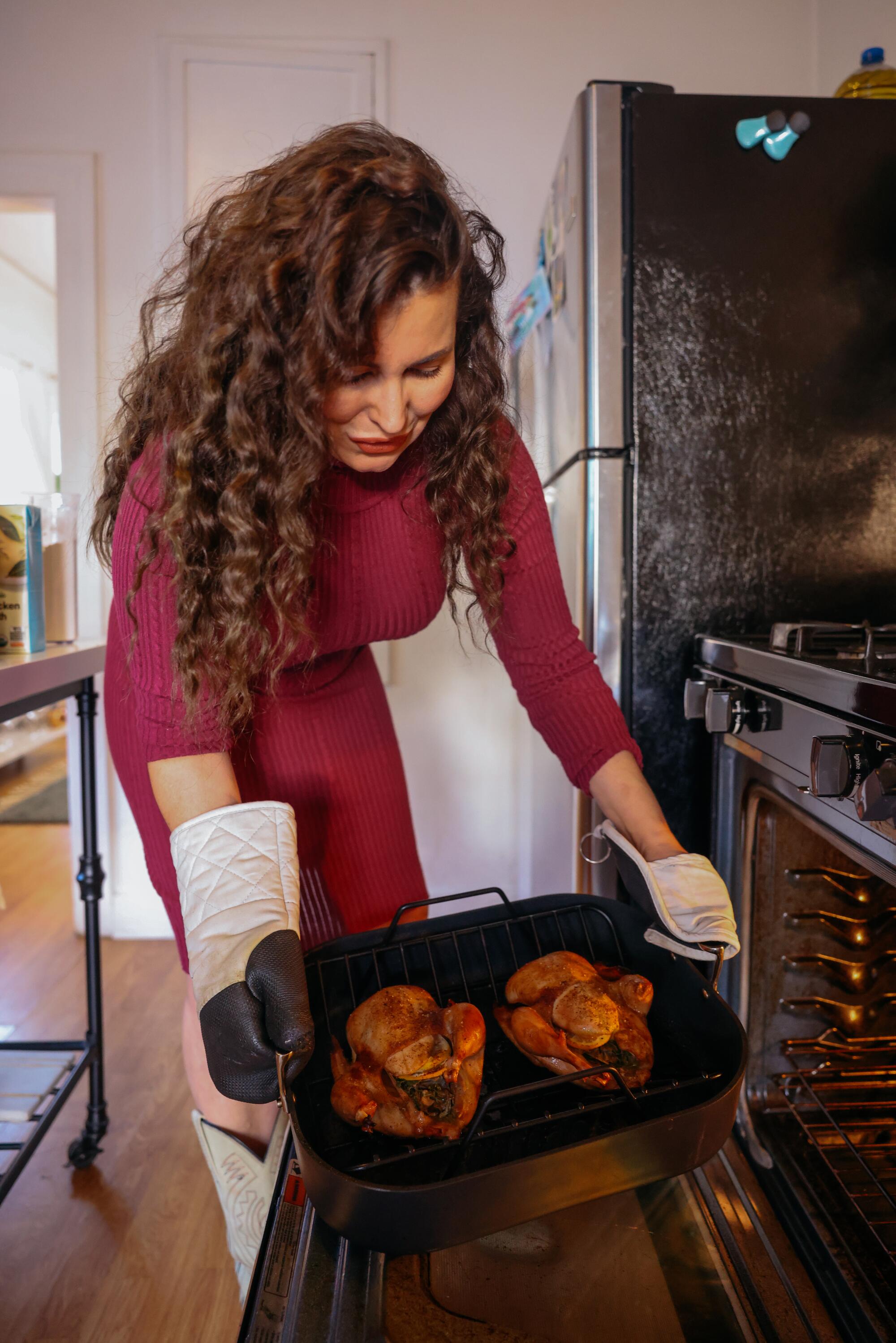
Cara McConnell, 42, design firm vice president, Atwater Village
“For Thanksgiving, because I am from Oklahoma and all of my family is still there, I don’t always go back home, and I love having Friendsgiving in L.A. And, because I personally find turkey overwhelming to cook, I turn to roasting small birds. It’s an easier task, and I like the personal-sized portions.
Before L.A., I lived in Chicago after college, and my boss there, Michan, spent his childhood splitting his time between Dublin and Paris. Dinners at his house in the fall were always roasting small game and making pâté from the birds for the appetizer.
Michan always made me feel welcome at his house in Chicago, and he and his wife opened my eyes to many types of cooking and also French wine for the first time. He was a mentor to me, not only as an architect but for opening my eyes to elevated cooking and entertaining. He was fascinated by my story and life journey. I think about him, especially on Friendsgiving, as we are willing to loosen up the decades of traditional family foods and we gather to experience the holiday in different terms that are just as delicious.”
Roast Pheasants With Double Cranberry Sauce
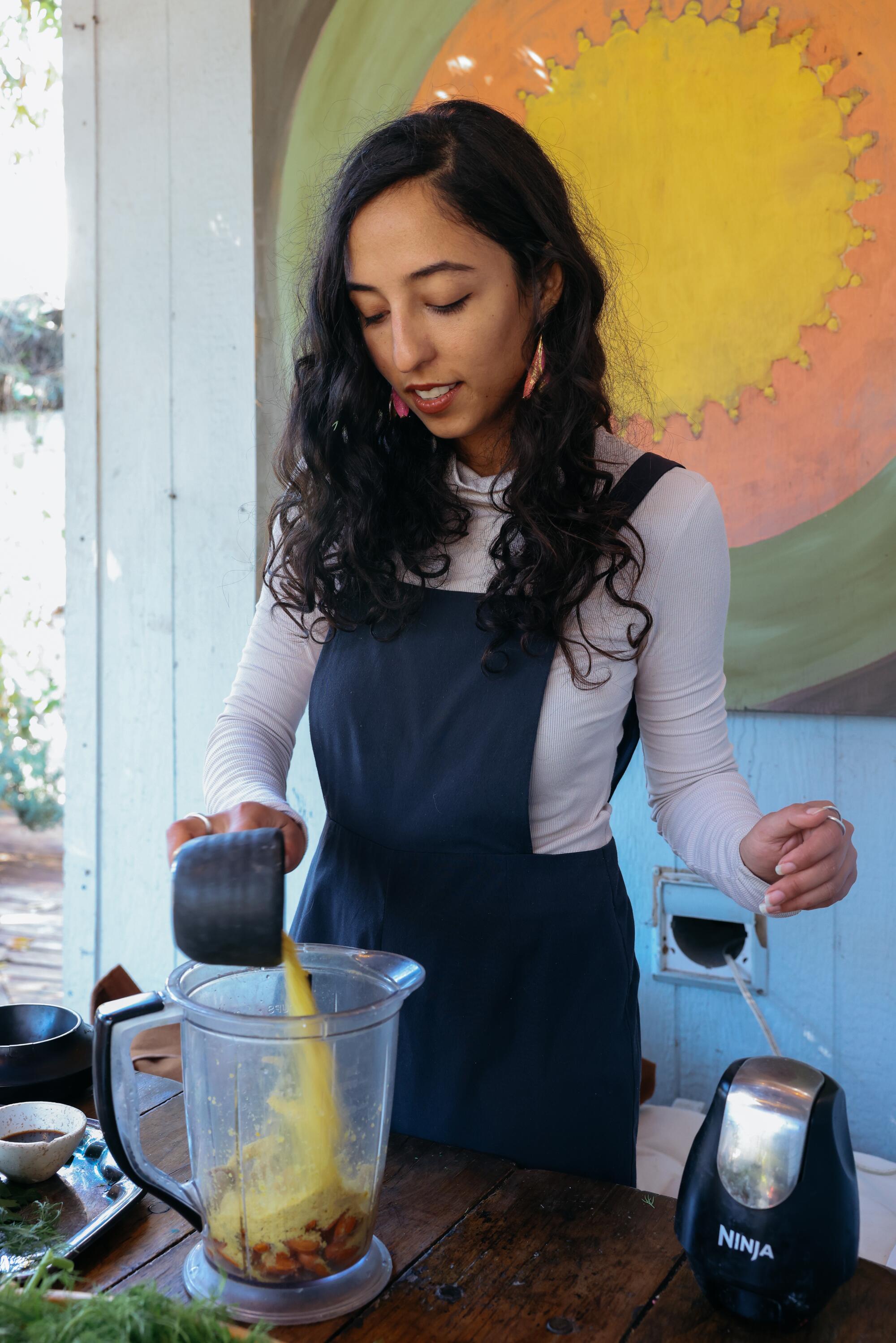
Sorina Vaziri, 31, artist, Mid-City
“This is a very nostalgic dressing to anyone who religiously ate the famous Krishna Lunch at University of Florida, where I went to school. If I remember correctly, a plate was $3, and there were unlimited refills, which, for broke students, made us go wild. The dressing was so good, so we’d dress not only the salad but anything on the plate with it.
A lot of my friends out here in L.A. are from UF, and we do an annual Friendsgiving potluck. So I make this salad every year to take us back a decade, to simpler times when we were broke and always hungry.”
Winter Salad With Hare Krishna Dressing
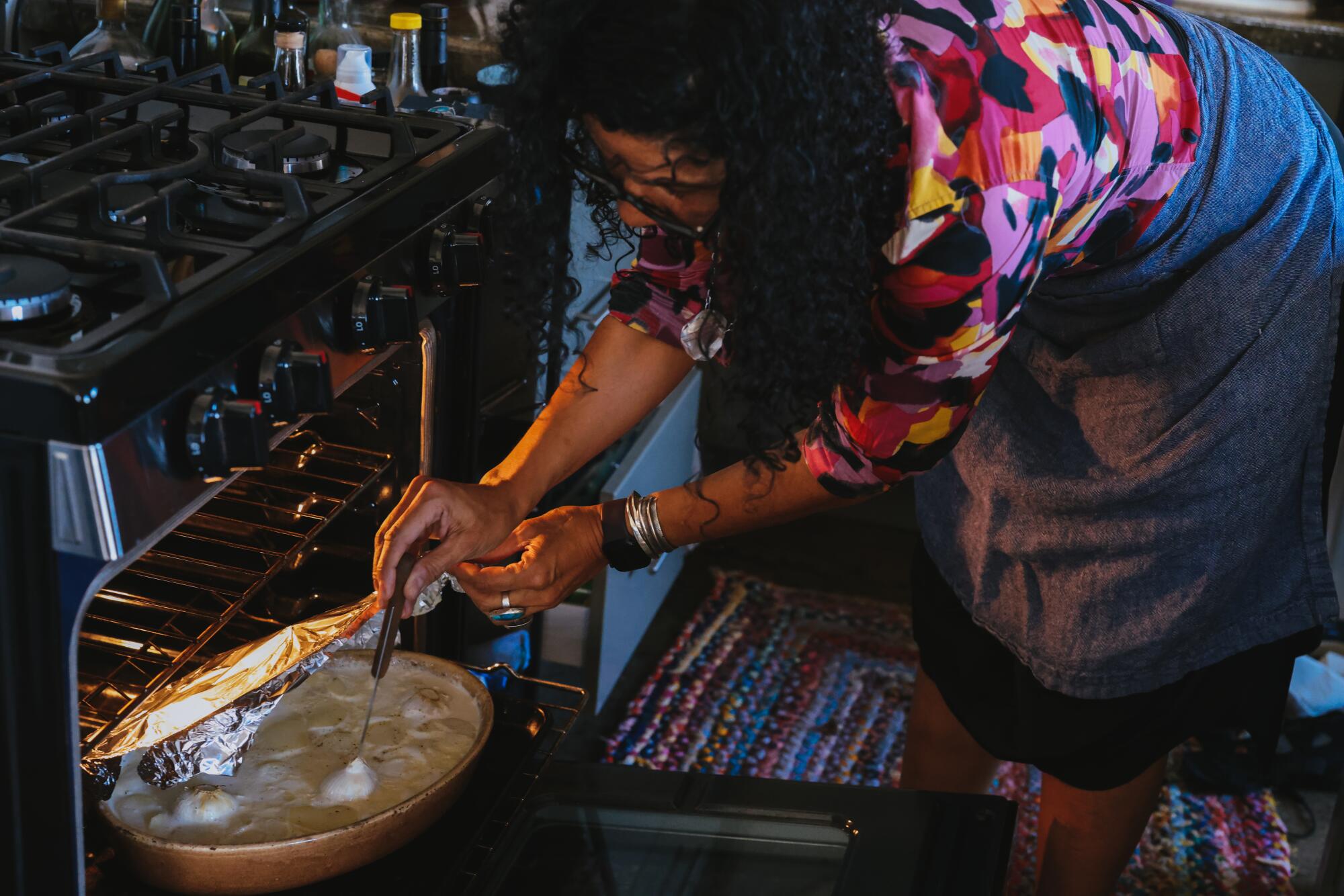
Fabienne Toback, documentary filmmaker, Arts District
“I grew up in the West Village of Manhattan, and as an only child, I would spend large swaths of time alone. But when I was in the second or third grade, I started going after school to my grandma’s (my father’s mother’s) place in Crown Heights. It was there that my love of cooking began. Grandma would let me concoct anything I wanted, under the sole condition that it be baked. (Why just baked? I’m not sure, but I have a vague memory of a horribly burnt pot that soaked in the sink for weeks …)
Never really loving sweets, I would favor a savory taste profile, so the gratin serves as a salty touchstone from that time. I don’t remember whether anything tasted particularly good or not, but I remember the uninterrupted time exploring food and flavors, and the unconditional embrace of Grandma’s love and support while I tinkered away in her Brooklyn kitchen.
On my mother’s side, I would spend the summer in Switzerland. [My grandmother] Satsi, as I affectionately called her, lived in Lausanne, a beautiful urban town on Lake Geneva. We would spend the long summer days hiking in the tangle of thick woods or the cooling alpine mountains, or lakeside in the glacially cold waters. Wherever and whatever we did, we would pack sandwiches to enjoy on our outings; whether it was on milk bread or a baguette, Gruyère cheese was always to be found.
Honey lightly sweetens these super-tender, pillowy yeast rolls, drenched in melted butter, baked until light golden, and finished with a pinch of flaky salt.
My Gratin Dauphinois is a self-created food memory and has become my signature dish for Thanksgiving. I wish I could say this dish was a recipe handed down by generations, but that would be a lie. It’s almost fail-proof, and always a crowd-pleaser. A little scoop on your Thanksgiving plate goes a long way; it is rich and creamy. It’s the comfort food you never knew you craved.
When I make this dish, it serves as a meditation, imbued with memories from my childhood, and allows me to commune with the women in my life who have helped me become the woman I am today, and for that, I am grateful.”
Gratin Dauphinois
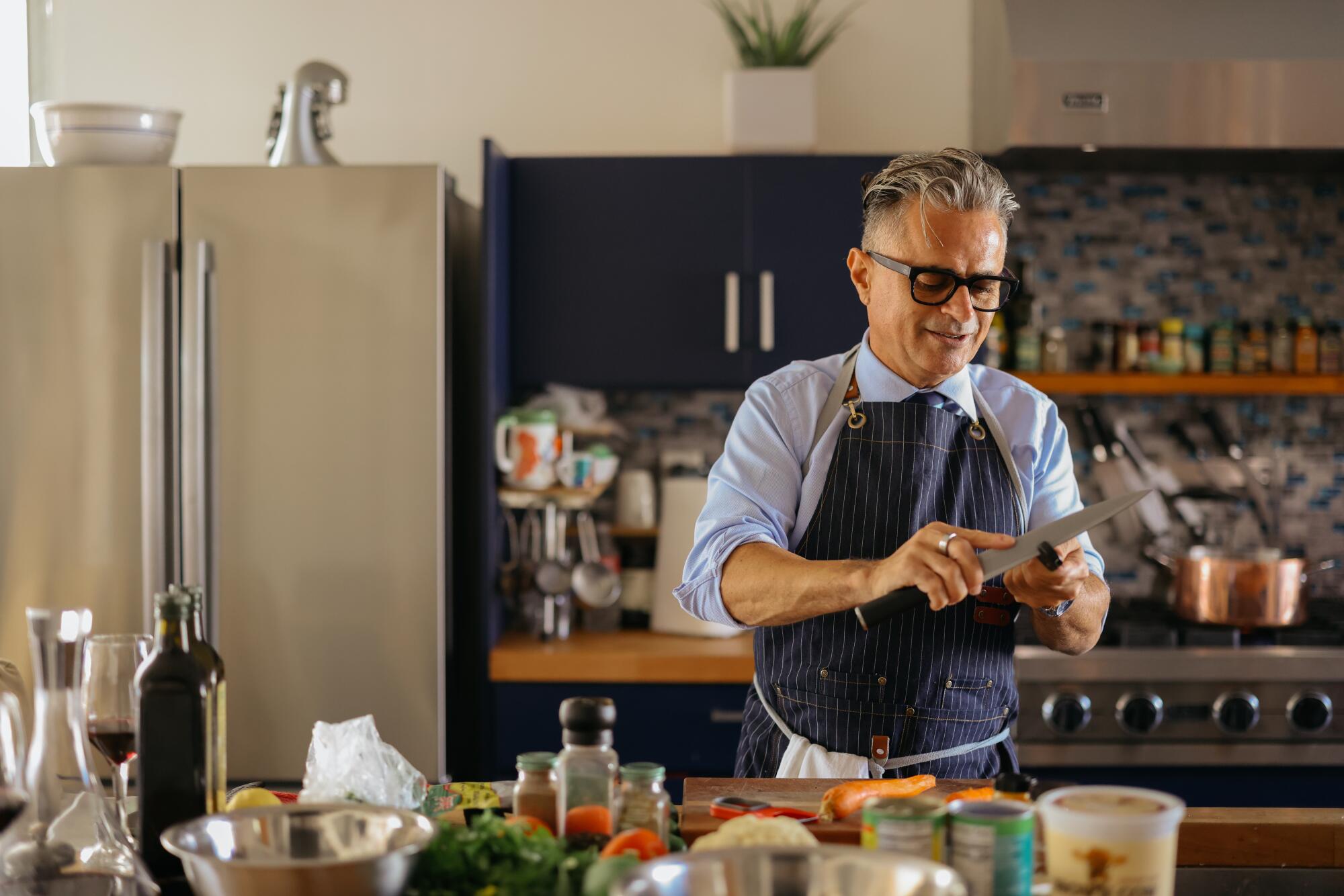
Hythum Kiswani, 53, commercial real estate broker, Playa del Rey
“I’m a first-generation Palestinian, immigrating to Northern California at the age of 9. This was just around the time of the Iran hostage crisis and, safe to say, it was not easy for a brown kid living in the ’burbs of NorCal. It didn’t matter that I wasn’t Persian; I was lumped in with anyone from the Middle East as Iranian, so I got a lot of bullying but with an enhanced cultural/racial component.
Fast-forward some years, and there was some form of assimilation but not enough for my liking. Thanksgiving dinner became a frustrating event for me. I was desperate to feel less abnormal — to just fit in and feel like I belonged — so I’d beg my mom and dad to have a typical American Thanksgiving dinner of turkey, mashed potatoes, stuffing, etc. My requests fell on deaf ears for a few years, but eventually a compromise was had: Sure, we’ll have turkey, but we’ll still have traditional Arabic meals meant for celebrations. So we’d usually have Maqluba. The dish has become a staple of my Thanksgiving meal because of the time and energy required to make it, the wonderfully intense aromatic flavors, and the link to my Palestinian heritage. It’s not found in other Arabic cultures. As such, it’s really a manifestation of families incorporating whatever ingredients were around in the kitchen to provide food for their family.
Now Maqluba is one of my favorite dishes. I usually request my sisters make it for me when I visit, and I, in turn, cook dishes from my travels for them. Maqluba varies by recipe: Some add garbanzo beans, others eggplant, and some put a plate in the pot to isolate the meat from the rice. One constant is that it’s a very tasty dish, full of flavor and with wonderful aesthetics and presentation. My mom and sisters all have their own way of preparing it, and I’ve borrowed the best of all of them — with my own touch.”
Maqluba (Palestinian Upside-down Chicken and Rice)
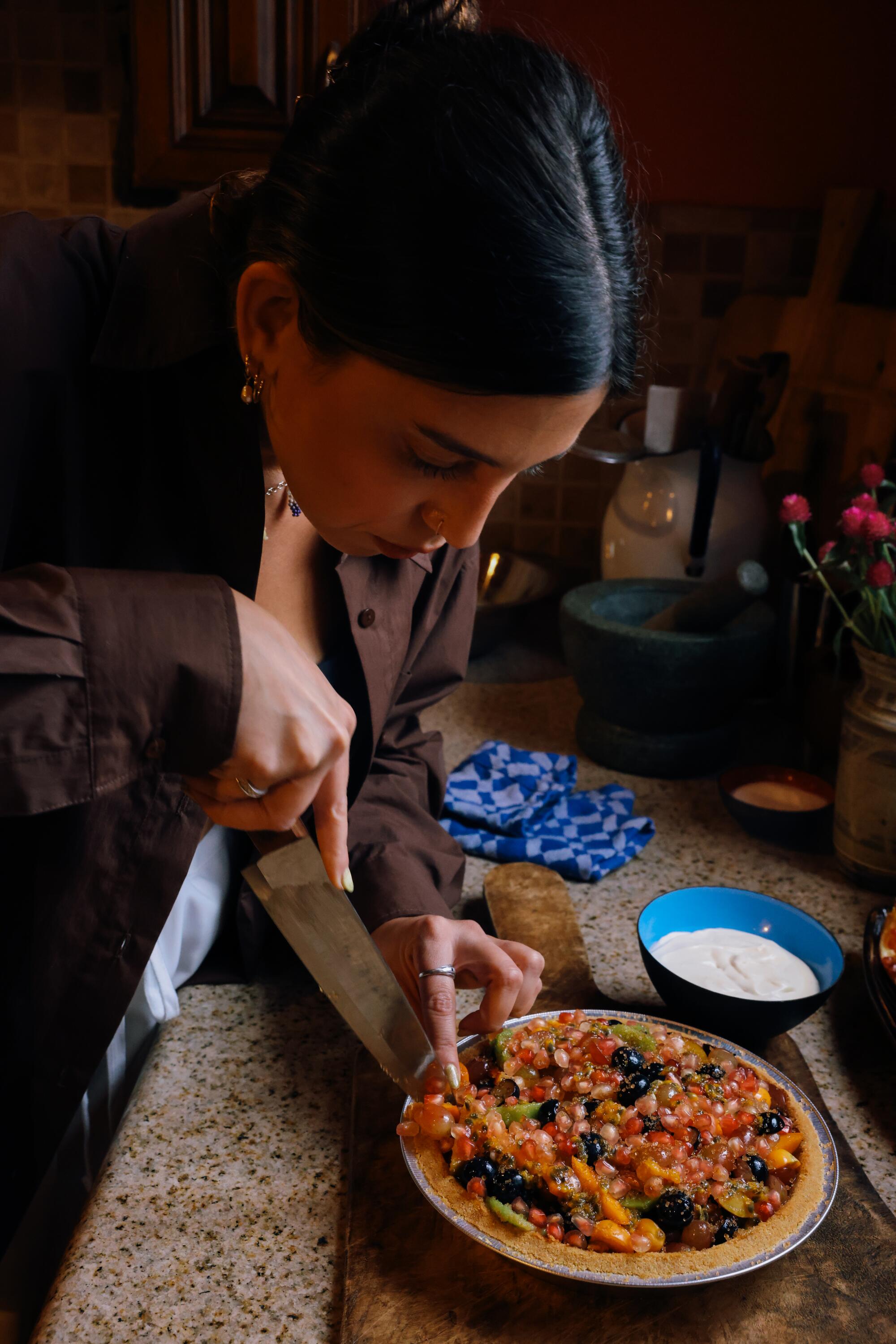
Karla Subero Pittol, 31, chef, Historic Filipinotown
“For as long as I’ve been celebrating Thanksgiving with my family, and for as long as I’ve been a chef and offered to lend a hand with the cooking, my dad has always taken full control of the meal, so I never really get to participate with any dishes other than dessert — as the resident pie lady of the family, that’s what they always stick me on.
Before I started making pies religiously, I’d always pick up a Viktor Benes fruit tart from the grocery store, since that’s a favorite in my house (we still have one at pretty much every celebration).
Cinnamon, nutmeg and ginger spice canned pumpkin in this classic Thanksgiving pie recipe. Blind-baking the crust ensures a crisp pastry to contrast the smooth custard filling.
My parents and I are all immigrants from Venezuela, with no family here when we originally arrived. Once our chosen family here started to grow and we started hosting Thanksgiving at my childhood home in Van Nuys, the fruit tart just started appearing. It’s always been a symbol for me of being at my dad’s house. He is the quintessential Latino who can be found daily — to this day — in the kitchen at some point cutting up fruit and sharing it only with whoever will walk up to the counter and eat it off the cutting board with him. That was me as a kid, and now it’s my three teen and tweenage little sisters living it out in real time.
The tart is all about the cut fruit, and I think that’s why it started showing up. Whether it was him that was buying it initially, our extended family caught on because now, other people bring it too.
I’d been dying to make my own version of it for years, and this is it. But I like to use persimmons, pomegranates, passion fruit, kiwi — fruit that says ‘the holidays.’”
Creamy 'Fruit Tart' Pie
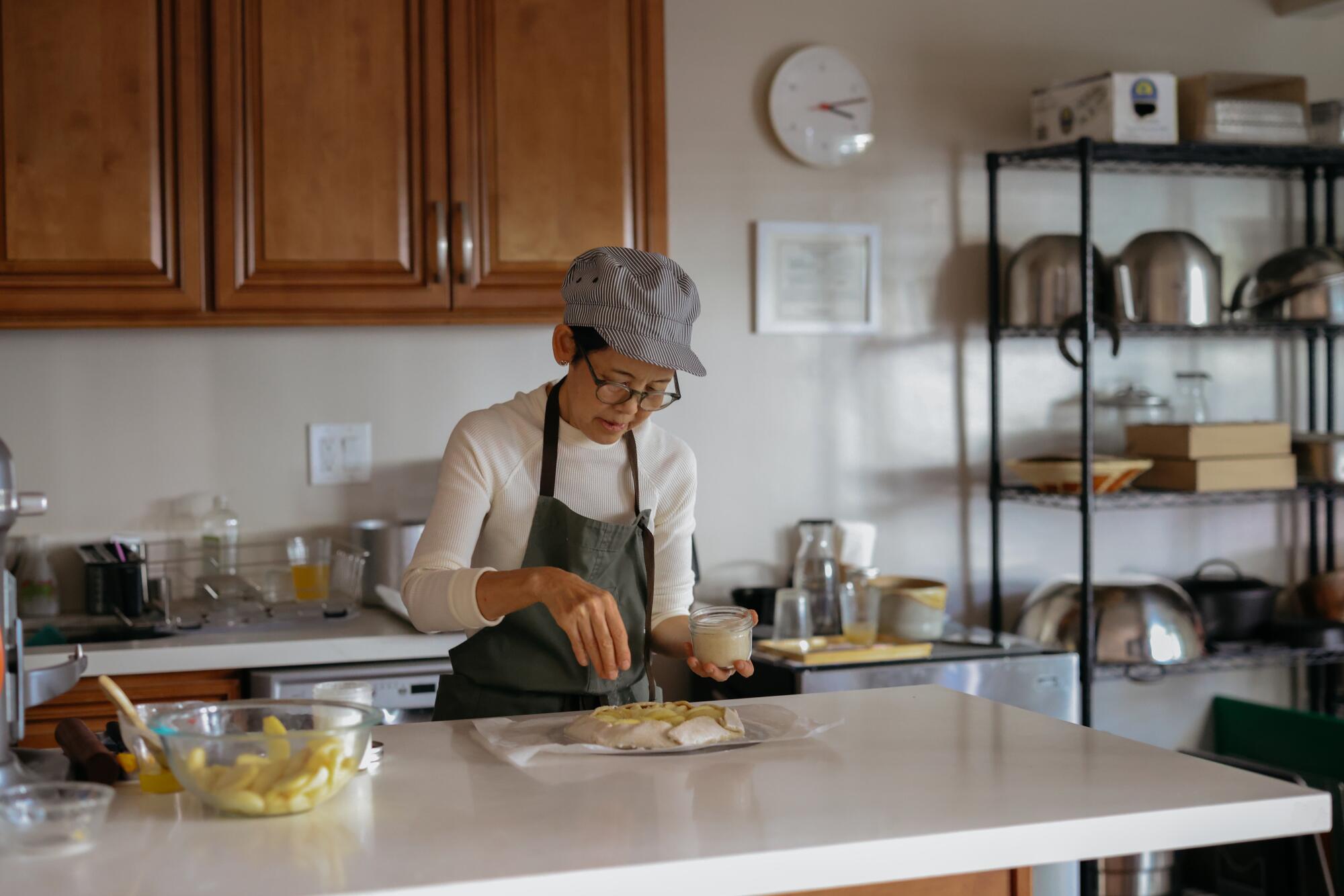
Fuyuko Kondo, 65, pâtissière, Pasadena
“The sweet smell of apples baking in the oven brings me back to memories of my mother who raised five children. Because of my father’s job as an airline executive, we moved back and forth between Japan and the United States a lot. Although Thanksgiving is not a Japanese holiday, and turkey is not a common poultry in Japan, they both meant a lot to my family. My mother would purchase the frozen turkey from an American supermarket. She got excited about the big bird, which to her meant she could invite lots of people, like foreigners who were away from home and alone.
As much as we all enjoyed her roasted turkey, her apple pie was actually the highlight of the feast. It was a latticed pie on a sheet tray with a precooked apple filling. In the center of the pie, there were roses made out of pie scraps. Her pie almost always came out perfect, flavorful and delicious, even though she never followed a recipe. Years have gone by since my mother’s apple pie days. I have tried to make an apple pie as good as hers, but I have yet to get a full approval from my siblings — until I came up with my Apple Galette in recent years.
My galette is made out of three components. The galette dough is not over-mixed, so as to achieve a flaky crust that keeps fresh for a couple of days. The green-apple compote filling has a tart flavor that enriches the flavor of the sweet red apples on top, which are soaked in sugar to take away excess water before baking. My American and French pastry skills make this galette, but its essence is the sweet memory of my mother on Thanksgiving day.”
Apple Galette
More to Read
Eat your way across L.A.
Get our weekly Tasting Notes newsletter for reviews, news and more.
You may occasionally receive promotional content from the Los Angeles Times.
